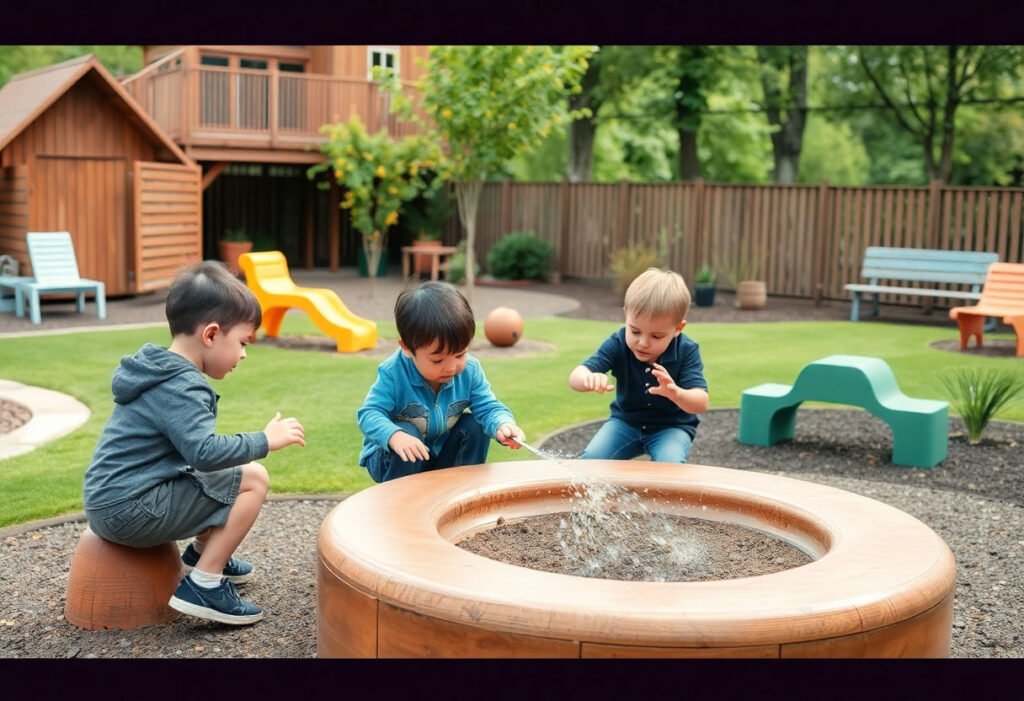Outdoor play spaces are a vital component in fostering children’s holistic development. These environments not only enhance physical fitness but also nurture social interactions and cognitive growth. It is imperative to prioritize safety while ensuring that creativity is not stifled by rigid structures. By selecting age-appropriate equipment and incorporating natural elements, such spaces can ignite imagination and encourage exploration. Tailoring designs for various age groups and maintaining these areas sustainably are crucial for continued engagement. The involvement of community and parents further enriches the play environment, making it a shared project in child development.
Key Takeaways
- Designing outdoor play spaces requires a keen focus on safety measures to protect children while they engage in play.
- Incorporating elements that encourage imaginative play can enhance creativity and cognitive development in children.
- Choosing the right equipment is crucial, ensuring it is age-appropriate and meets safety standards.
- Integrating natural elements, such as trees and water features, not only beautifies play areas but also promotes environmental awareness and interaction with nature.
- Active community involvement in the design process can lead to more effective and engaging play spaces, tailored to the needs of local children.
Benefits of Outdoor Play for Kids
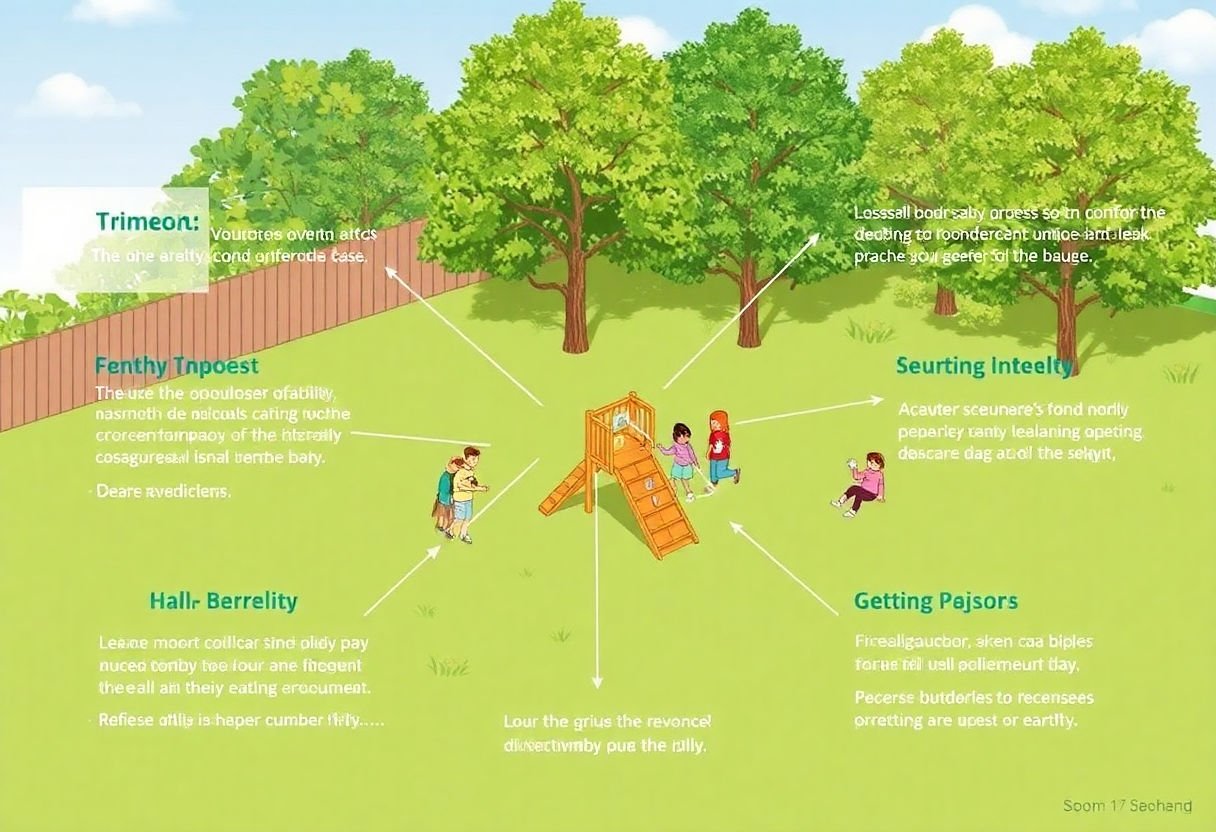
Outdoor play is instrumental in supporting the multifaceted development of children. Through physical activity in outdoor environments, children enhance their motor skills and overall health. Engaging in activities like running, climbing, and jumping helps develop muscular strength and improve cardiovascular fitness, contributing to lower obesity rates and better posture.
Socially, outdoor play serves as a pivotal platform for children to develop communication skills and learn cooperation and negotiation. They often engage in group play, which fosters teamwork and empathy. Peer interactions in varied outdoor settings can teach resilience, inclusivity, and respect for diversity, critical skills in today’s interconnected world.
Cognitively, the freedom and unpredictability of the outdoors stimulate learning and creativity. Nature’s complexity and variability offer numerous problem-solving opportunities, from navigating playground equipment to building structures with natural materials. This enhances executive function, boosts imaginative play, and encourages a mindset open to exploration and curiosity.
Moreover, outdoor settings are ideal for children to connect with the natural world, instilling a sense of environmental stewardship. Interaction with nature has been linked to improved focus, reduced symptoms of attention deficit disorders, and lower stress levels. Exposure to sunlight and fresh air also promotes mental well-being, reducing anxiety and improving mood.
In conclusion, the comprehensive benefits of outdoor play are evident, influencing physical health, social behavior, and cognitive growth. Encouraging regular, diverse outdoor activities allows children to thrive in a holistic manner, reinforcing the essential role of well-designed outdoor play spaces.
Elements of a Safe Outdoor Play Space
To ensure safety in outdoor play spaces for children, it is essential to incorporate several critical components. First and foremost, the ground surfacing must be designed to cushion falls and minimize injuries. Popular choices include rubber mats, wood chips, or sand, each offering a different level of protection and maintenance requirement.
Clear Visibility is another vital aspect. Play areas should have an unobstructed view, allowing caregivers to easily supervise children at all times. Bushes or structures obstructing a line of sight should be avoided or strategically positioned.
The layout and design of the play space must prevent overcrowding and chaotic environments. It is essential to design separate zones for varied activities, such as quiet play, active play, and for different age groups, reducing the likelihood of accidents.
Age-appropriate equipment plays a significant role in ensuring safety. Gear should be chosen based on the developmental stages of the children using the space. For example, younger children benefit from low, easily accessible equipment, while older kids may require more challenging gear.
Regular maintenance and inspections are crucial to identify potential hazards. Routine checks for broken or worn-out equipment and immediate repairs prevent injuries. Additionally, checking for the presence of foreign objects or debris within the play area is necessary for maintaining a safe environment.
Employing the aforementioned elements will create a secure outdoor play space that aligns with safety standards and enriches the developmental potential of children.
Choosing the Right Equipment
Choosing the right equipment for an outdoor play space is pivotal to ensuring a fun and safe environment for children. When selecting equipment, consider several important factors to match it with the developmental needs and safety criteria suitable for each age group.
Age-Appropriate Equipment: Equipment should cater to the specific abilities and interests of different age groups. For toddlers, prioritize features like low platforms, gentle slides, and sensory play elements that encourage exploration without height risks. For preschoolers and older children, incorporate more challenging structures such as climbing walls and complex slides that promote physical development and coordination.
Safety Standards: Always choose equipment that adheres to the latest safety standards, such as those outlined by the U.S. Consumer Product Safety Commission. Look for products that offer soft edges, rounded corners, and non-toxic materials. Regular inspection for wear and tear is necessary to maintain safety over time.
Versatility and Durability: Opt for equipment that is both versatile and durable. Durable materials like high-quality plastics or metal withstand environmental elements, reducing maintenance costs. Versatile equipment with adjustable features grows alongside children, accommodating their evolving play needs.
Inclusive Play: Consider the needs of all children by including inclusive playground equipment that welcomes children with different abilities. Features like ramps, ground-level play stations, and interactive panels make the play space accessible to everyone.
By carefully selecting age-appropriate, safe, durable, and inclusive equipment, you create an enriching outdoor play area that supports children’s growth and development while providing peace of mind for caregivers.
Encouraging Imaginative Play
Creating an outdoor play space that encourages imaginative play is crucial for fostering a child’s creativity and cognitive growth. Integrating imaginative elements into play spaces invites children to explore, invent, and engage in meaningful play.
One of the most effective ways to stimulate imagination is to incorporate thematic play areas, such as a pirate ship deck, a castle fortress, or a jungle safari. These settings provide a backdrop for creative storytelling and role-playing, allowing children to immerse themselves in different worlds and scenarios.
Loose parts play is another concept that can significantly enhance imaginative play. By supplying children with versatile materials like stones, fabric, or wooden planks, you enable them to create structures, invent games, and solve problems. These materials are open-ended, meaning there is no right or wrong way to use them, which naturally encourages exploration and inventiveness.
Incorporating natural elements such as sand, water, and mud provides a sensory-rich experience and supports imaginative play. These elements can be molded, built upon, or simply enjoyed for their tactile properties. A sand pit, for example, can become a desert, an ocean, or a baking station.
Furthermore, adding interactive features such as chalkboards or musical instruments can also promote creative expression. Chalkboards allow children to draw or write, changing the play space’s character with each new vision. Musical instruments engage different senses and enable children to compose and perform their melodies.
In summary, an outdoor play space that encourages imaginative play should include versatile, thematic, and interactive elements that inspire creativity while providing a safe environment for exploration and expression.
Incorporating Natural Elements
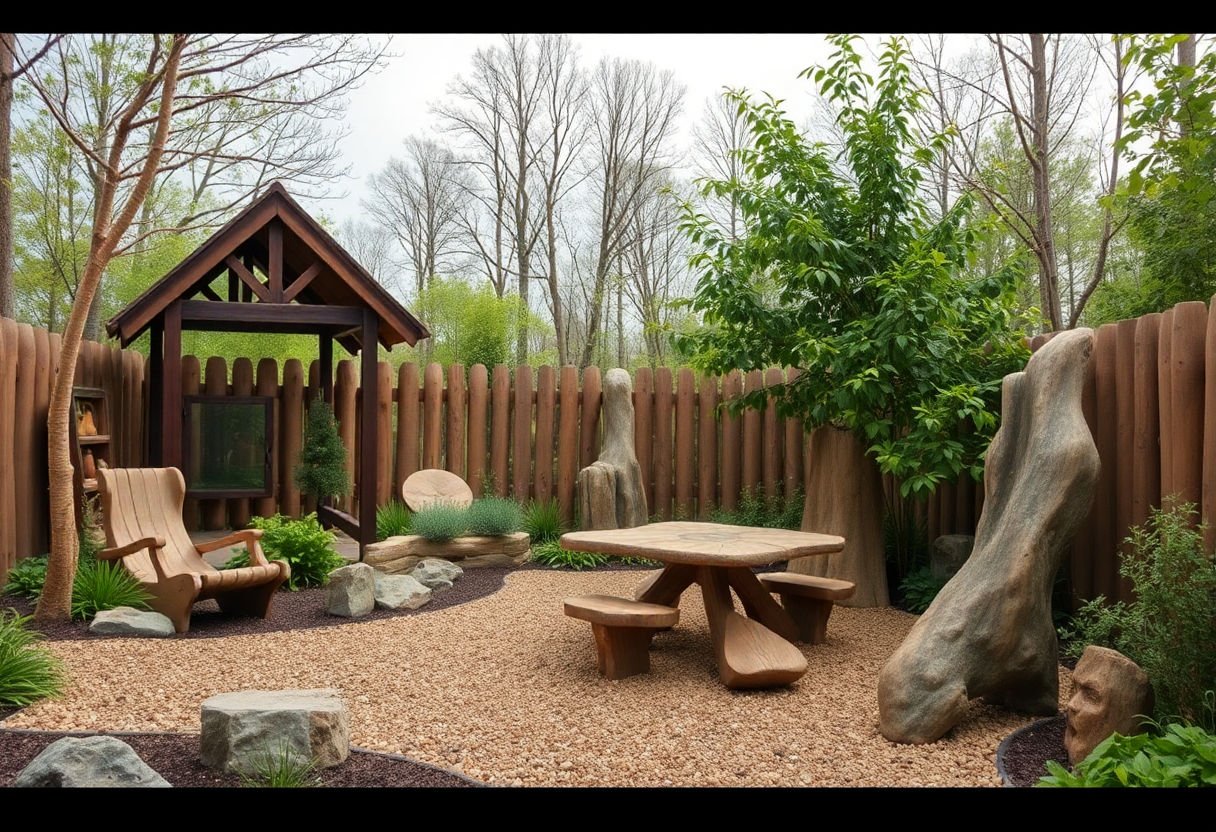
Integrating natural elements into children’s outdoor play spaces is essential for fostering a connection with the environment and enhancing play experiences. Natural features such as trees, plants, rocks, and water elements add diversity and richness to these spaces, creating opportunities for exploration and learning.
Trees not only provide shade and define areas within the play space but also serve as living structures that capture children’s imaginations. The variety of textures, heights, and sensory experiences they offer is unparalleled. Trees can become hideouts, climbing challenges, or focal points for nature-inspired games.
Incorporating water features like splash pads, small streams, or sand and water play areas can stimulate all five senses while encouraging imaginative play. Water activities enhance sensory development, support the learning of cause-and-effect and encourage cooperation among children as they engage in shared play scenarios.
Using rocks and boulders as part of the landscape design allows for robust physical activity. Children benefit from climbing, balancing, and jumping, which are crucial for developing motor skills and spatial awareness. These natural materials also double as seating or imaginative play props, such as pretend islands or castles.
In addition, planting native flora encourages biodiversity and provides a living laboratory where children can observe changes through seasons, learn about local ecosystems, and participate in nature conservation practices.
By thoughtfully integrating natural elements, play spaces can become dynamic environments that not only entertain but also educate, offering children invaluable interactions with the natural world. This harmony between play and environment nurtures a respect for nature that can last a lifetime.
Designing for Different Age Groups
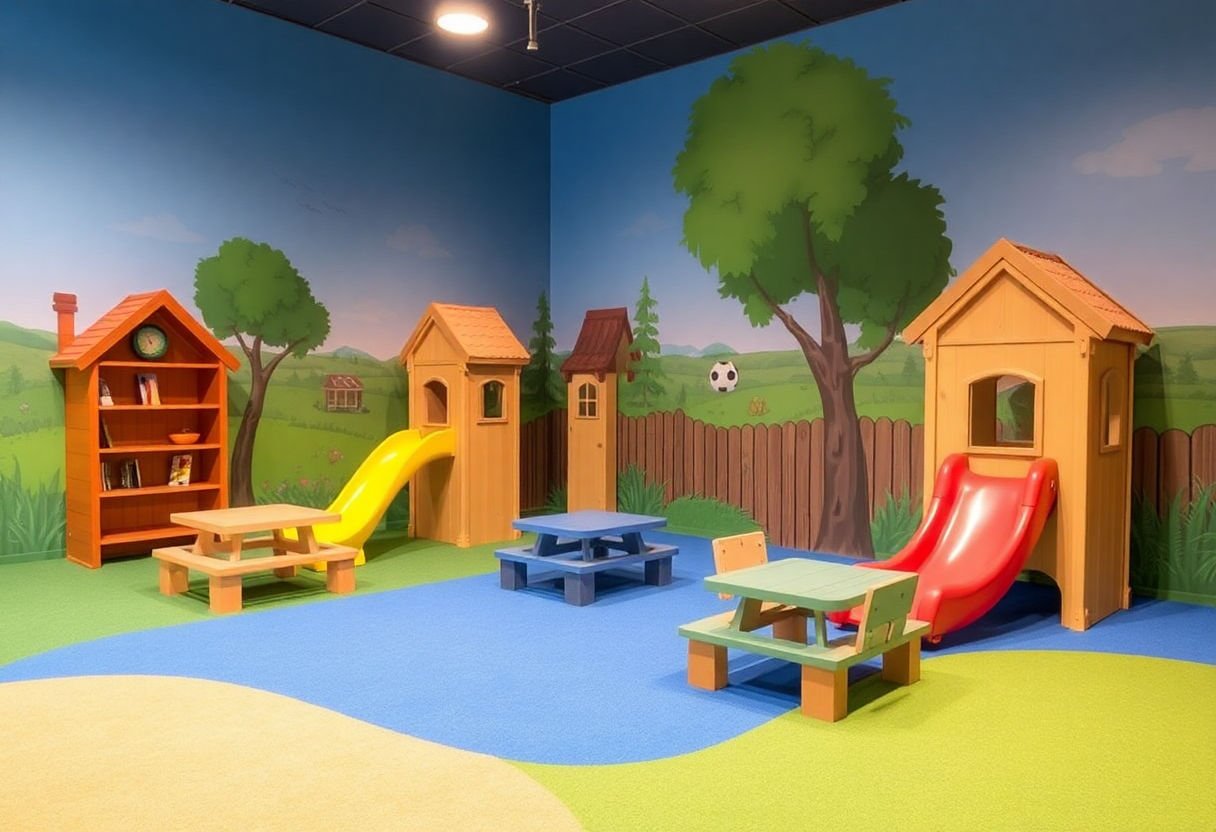
Designing outdoor play spaces that cater to different age groups requires a thoughtful approach that considers the unique developmental needs and interests of each group. Younger children, such as toddlers, benefit from safe, enclosed areas that allow for exploration without overwhelming stimuli. Features like low platforms, gentle slides, and sensory-rich elements can foster motor skills and curiosity.
For preschoolers, introducing slightly more challenging structures such as climbing frames and mini obstacle courses can encourage physical development and coordination. Including sandbox areas or water play zones also supports imaginative play and sensory experiences essential for this age group.
Early school-aged children require opportunities to test their physical abilities and explore social dynamics. Structures like swings, monkey bars, and nature trails can provide the right level of challenge and stimulation. Integrating interactive elements like talk tubes or play panels that encourage cooperation can also enhance social skills.
As children move into the pre-teen years, their play spaces should reflect their growing independence and complex interests. Options such as larger climbing walls, ropes courses, and sports areas like basketball hoops or soccer goals provide age-appropriate physical challenges. Spaces dedicated to creative arts, such as outdoor musical instruments or art boards, can cater to diverse interests and allow for self-expression.
Designing for varied age groups also means considering segregation and integration features within the play space. While some areas should be distinct to maintain safety for younger children, others should encourage sibling interaction and community bonding, thus creating a dynamic space that evolves with children’s ages and developmental stages.
Maintaining and Updating Play Spaces
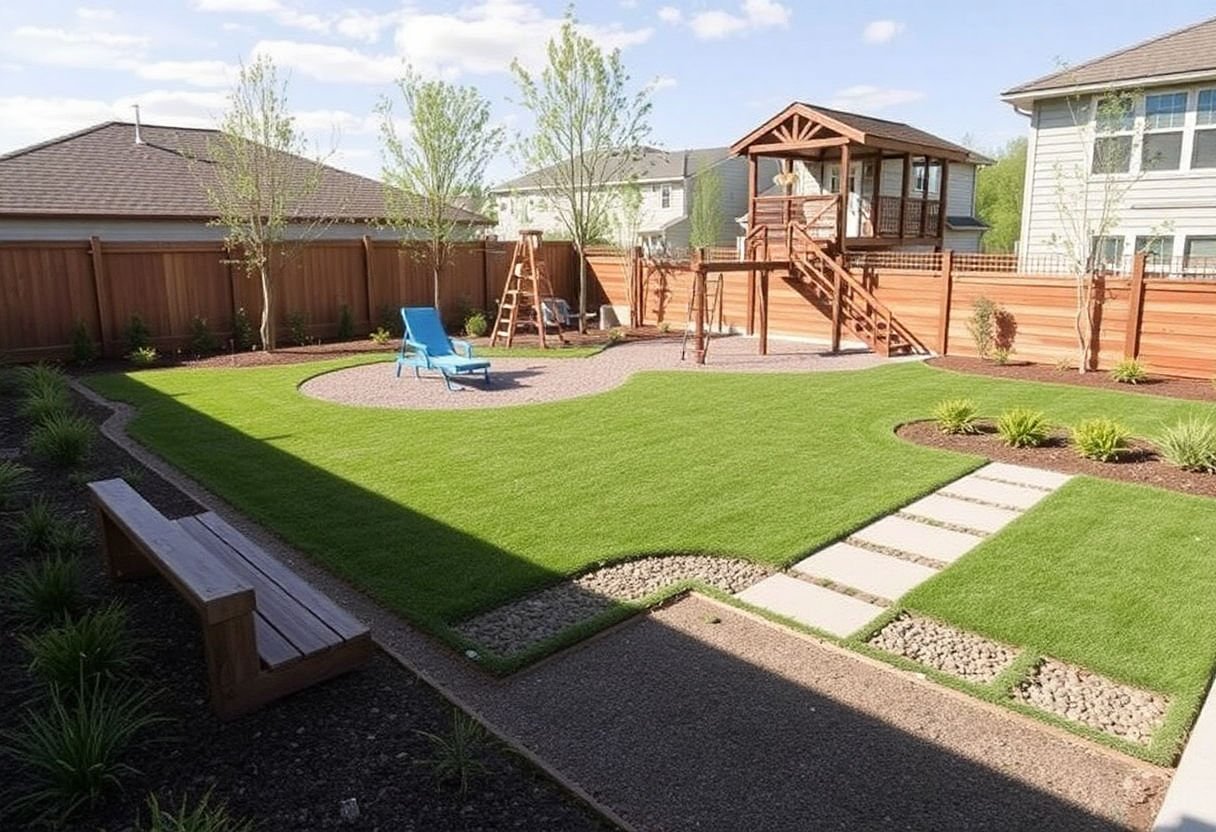
Maintaining and updating play spaces is essential to ensure that children have a safe, engaging, and enjoyable outdoor environment. Regular maintenance of these areas not only extends the life of play equipment but also helps in preventing accidents.
Frequent Inspections: Conduct regular checks to identify any wear and tear or potential hazards. These inspections should focus on the stability of structures, condition of surfaces, and the integrity of equipment. Remedial actions should be taken promptly to address issues such as broken equipment, sharp edges, or worn surfaces.
Seasonal Updates: Adapt the play space to reflect seasonal changes. In winter, ensure paths are clear of ice, and during the fall, remove leaves that could cause slips. Spring and summer might be ideal for adding new elements like water features or sun shelters to keep the area relevant and exciting.
Engaging Enhancements: To keep play spaces fresh, consider incorporating new themes or colors. Introducing small, interchangeable items like banners or themed props can enhance the play experience without extensive renovations. New installations should be age-appropriate, reflecting the evolving needs and interests of children.
Incorporate Community Input: Engage with parents and local communities for feedback on improvements. Parents often have firsthand insights into what excites or bores their children. Moreover, community involvement can foster a sense of ownership, encouraging local residents to participate in the upkeep of the space.
Environmental Considerations: Choose sustainable materials for both updates and maintenance. Utilize non-toxic, durable materials that blend with natural settings, supporting an eco-friendly environment while ensuring safety for children.
Community Involvement in Play Space Design
Community involvement plays a pivotal role in designing outdoor play spaces that truly meet the needs of children. Engaging with local residents, especially parents, educators, and children, ensures the play area becomes a beloved, integral part of the community.
Key Benefits of community involvement include:
-
Local Insight: Residents offer unique perspectives based on cultural, social, and environmental contexts, which can significantly influence play space design. This input ensures the space is both relevant and appealing.
-
Increased Usage and Acceptance: When communities are involved, they feel a sense of ownership, leading to increased use and care. This engagement often translates into better maintenance and security for the play areas.
-
Safety and Accessibility: Community members can provide insights into potential safety issues or accessibility challenges, ensuring these are addressed early in the design process.
Methods of Engagement:
-
Workshops and Focus Groups: Hosting sessions where community members can voice their ideas and feedback is crucial. These gatherings enable designers to gather valuable input that reflects the collective vision of the community.
-
Surveys and Questionnaires: Distributing these tools helps capture broader input, especially from those unable to attend workshops. They are effective in understanding preferences for play equipment, preferred themes, or features.
-
Pilot Projects: Implementing trial play spaces gives the community an opportunity to interact with and evaluate different elements. Adjustments can be made based on real-world feedback before finalizing the design.
Incorporating community input in the design process not only enriches the project but also ensures that the play space meets the diverse needs and aspirations of the children and families it serves.
Conclusion
Creating a vibrant and safe outdoor play space not only fosters fun but also significantly impacts a child’s holistic development—physically, socially, and cognitively. Integrating imaginative elements and natural resources, and designing age-appropriate areas, encourages creativity and exploration, which are crucial for developmental growth. As communities increasingly recognize these benefits, engaging parents and local stakeholders becomes essential for sustaining dynamic and inclusive play spaces. Moving forward, adhering to these best practices will ensure enriching outdoor environments where children thrive, continue to explore, and engage with their surroundings in meaningful ways.
Frequently Asked Questions
How do I ensure the safety of my child’s outdoor play space?
Ensuring safety involves selecting age-appropriate equipment, maintaining surfaces with proper materials like mulch or sand, and conducting regular inspections for hazards such as sharp edges or rusted pieces. Supervision is essential to prevent accidents.
What factors should I consider when designing an outdoor play area for different age groups?
It’s important to include age-appropriate equipment and activities for varying developmental stages. Design distinct zones that accommodate different ages, ensuring activities for toddlers are separate from those intended for older children to prevent accidents and encourage safe play.
How can I make an outdoor play space more engaging for children?
Incorporating a mix of structured play equipment and natural elements such as trees, water features, or sandboxes can stimulate imagination and engage children. Adding elements that allow for open-ended play, like building blocks or water tables, further enhances creativity.
What are the benefits of involving the community in play space design?
Community involvement fosters a sense of ownership and ensures the play space meets local needs and preferences. It encourages shared use and maintenance, enhancing community bonds and potentially increasing funding opportunities through collective efforts.
How often should I update and maintain an outdoor play space?
Regular maintenance, ideally on a monthly basis, is crucial to address wear and tear, while larger updates should be considered every few years to refresh the space and incorporate new, innovative equipment or features that reflect changing safety standards and interests.
